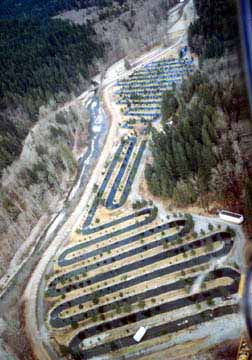a Major Tributary of the Fraser River
"The Harrison watershed should be untouched for the salmons' sake."
Per Saxvik, P.Eng.
Harrison Lake, near the town of Agassiz, east of Vancouver, British Columbia Canada, has recently (June 1999) been promoted as a domestic water resource for the metropolitan area of Greater Vancouver. The proponents of this domestic water resource, the Greater Vancouver Regional District (GVRD), appear to be extremely uninformed about the Harrison System Watershed and its environmental vulnerability.
The Harrison River and tributaries to the Harrison comprise one of the very few, possibly the only watershed in Canada which support all six species of salmon: Sockeye, Pink, Chum, Chinook, Coho and Steelhead
Sockeye Salmon spawn and rear in the Harrison River just up from Harrison Bay, in Weaver Creek and Weaver Creek Spawning Channel which drain into Harrison River below the lake, Big Silver Creek which drains into Harrison Lake, Upper Lillooet River & tributaries including the Birkenhead River upstream of Lillooet Lake. Specifically the Weaver Creek Sockeye are unique in that they, as fry, migrate down to the Harrison River and then up Harrison River against the flow to Harrison Lake to rear. Pink and Chum salmon are abundant in the Weaver, Sakwi and Harrison streams. Chinook, Coho and Steelhead are found throughout the system. Total population (spawners and catches) of these salmon are numbered in the millions most years.
The salmon in the Harrison River below Harrison Lake are specifically vulnerable during low flow period. Any diversion of water from the Harrison River and Lake System would reduce the natural flow jeopardizing the up-river migration of adult salmon. Frequently, at existing natural run-off conditions in the Harrison River between the lake and the Fraser River, the natural spawning beds go partially dry at spawning time and during winter and early spring at very low water periods. This limits the gravel area available for spawning salmon. Survival of salmon eggs and alevins incubating in the gravel beds depend on oxygen within the water and unless adequate flow is maintained over the spawning beds and within the gravel during these low flow periods, many salmon eggs would not survive.
The Harrison River/Lake System is one of the few, if not the only tributary watershed on the Lower Fraser still unspoiled by major developments. For several decades the International Pacific Salmon Fisheries Commission (1937-1985) and DFO were successful in protecting and enhancing the fishery resources in the Harrison System. Diverting water from Harrison Lake would sacrifice large populations of salmon. The proponents of Harrison Lake as a domestic water resource have a duty to educate themselves about all environments and resources and not just make headlines for political purposes.
From the above it is clear that using the Harrison Lake as a domestic water source for the Lower Mainland could be disastrous for the present environment.
